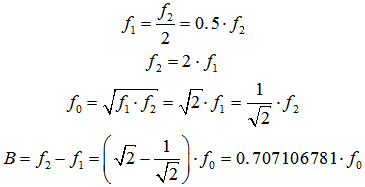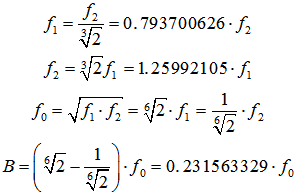http://www.sengpielaudio.com/calculator-octave.htm

Three adjacent one-third octave bands (1/3 octave bands) belong to one octave band.| | Level of one-third octave band 1 | dB | Level of one-third octave band 2 | dB | Level of one-third octave band 3 | dB | | | | ↓ | | | | Combined octave band level | dB | | |
|
| | Octave band level | dB | | | | ↓ | | | | Level of one-third octave band 1 | dB | Level of one-third octave band 2 | dB | Level of one-third octave band 3 | dB | | |
|
Should the level of an octave band be converted to one-third octave
bands, the energy of the octave band can be divided by three. This
corresponds to a reduction of (−)4.771 dB for each 1/3 octave band. |
| Calculate: Octave band level LΣ of three one-third octave band levels L1, L2, and L3: |
Calculator: Adding of equal levels of 1/3 octave bands Octave-band filters (1/1) and one-third octave-band filters (1/3) Simply enter the value to the left or the right side.
The calculator works in both directions of the ↔ sign. |
| | Number of 1/3 oct bands n
| ↔ | Increase of level Δ L
dB |  | |  | Three 1/3 octave bands are one octave band |
The total level in dB is the level of one band plus the increase in level. Octave bands One-third octave bands
ISO
Band numbers | Octave band
Center frequency | One-third octave band
Center frequencies | 11, 12, 13 | 16 Hz | 12.5 Hz, 16 Hz, 20 Hz | 14, 15, 16 | 31.5 Hz | 25 Hz, 31.5 Hz, 40 Hz | 17, 18, 19 | 63 Hz | 50 Hz, 63 Hz, 80 Hz | 20, 21, 22 | 125 Hz | 100 Hz, 125 Hz, 160 Hz | 23, 24, 25 | 250 Hz | 200 Hz, 250 Hz, 315 Hz | 26, 27, 28 | 500 Hz | 400 Hz, 500 Hz, 630 Hz | 29, 30, 31 | 1000 Hz | 800 Hz, 1000 Hz, 1250 Hz | 32, 33, 34 | 2000 Hz | 1600 Hz, 2000 Hz, 2500 Hz | 35, 36, 37 | 4000 Hz | 3150 Hz, 4000 Hz, 5000 Hz | 38, 39, 40 | 8000 Hz | 6300 Hz, 8000 Hz, 10000 Hz | 41, 42, 43 | 16000 Hz | 12500 Hz, 16000 Hz, 20000 Hz |
Standard frequencies for acoustic measurements according to EN ISO 266 | 1st octave cycle | 31.5 | | | | | | 63 | | | | | | 125 | | | | | | 250 | | | 2nd octave cycle | | | | 45 | | | | | | 90 | | | | | | 180 | | | | | | 1st 1/3 octave cycle | 31.5 | | 40 | | 50 | | 63 | | 80 | | 100 | | 125 | | 160 | | 200 | | 250 | | | 2nd 1/3 octave cycle | | 35,5 | | 45 | | 56 | | 71 | | 90 | | 112 | | 140 | | 180 | | 224 | | 280 | | 1st octave cycle | | | | | 500 | | | | | | 1000 | | | | | | 2000 | | | | | 2nd octave cycle | | 355 | | | | | | 710 | | | | | | 1400 | | | | | | 2800 | | 1st 1/3 octave cycle | 315 | | 400 | | 500 | | 630 | | 800 | | 1000 | | 1250 | | 1600 | | 2000 | | 2500 | | | 2nd 1/3 octave cycle | | 355 | | 450 | | 560 | | 710 | | 900 | | 1120 | | 1400 | | 1800 | | 2240 | | 2800 | | 1st octave cycle | | | 4000 | | | | | | 8000 | | | | | | 16000 | | | | | | | 2nd octave cycle | | | | | | 5600 | | | | | | 11200 | | | | | | 22400 | | | | 1st 1/3 octave cycle | 3150 | | 4000 | | 5000 | | 6300 | | 8000 | | 10000 | | 12500 | | 16000 | | 20000 | | 25000 | | | 2nd 1/3 octave cycle | | 3550 | | 4500 | | 5600 | | 7100 | | 9000 | | 11200 | | 14000 | | 18000 | | | | |
Center, lower, and upper frequencies for standard set of octave
and 1/3 octave bands covering the audible frequency range. |
Octave Band | 1/3 Octave Band | Lower
Frequency
f1 (Hz) | Center
Frequency
f0 (Hz) | Upper
Frequency
f2 (Hz) | Lower
Frequency
f1 (Hz) | Center
Frequency
f0 (Hz) | Upper
Frequency
f2 (Hz) | 22 | 31.5 | 44 | 22.4 | 25 | 28.2 | 28.2 | 31.5 | 35.5 | 35.5 | 40 | 44.7 | 44 | 63 | 88 | 44.7 | 50 | 56.2 | 56.2 | 63 | 70.8 | 70.8 | 80 | 89.1 | 88 | 125 | 177 | 89.1 | 100 | 112 | 112 | 125 | 141 | 141 | 160 | 178 | 177 | 250 | 355 | 178 | 200 | 224 | 224 | 250 | 282 | 282 | 315 | 355 | 355 | 500 | 710 | 355 | 400 | 447 | 447 | 500 | 562 | 562 | 630 | 708 | 710 | 1,000 | 1,420 | 708 | 800 | 891 | 891 | 1,000 | 1,122 | 1,122 | 1,250 | 1,413 | 1,420 | 2,000 | 2,840 | 1,413 | 1,600 | 1,778 | 1,778 | 2,000 | 2,239 | 2,239 | 2,500 | 2,818 | 2,840 | 4,000 | 5,680 | 2,818 | 3,150 | 3,548 | 3,548 | 4,000 | 4,467 | 4,467 | 5,000 | 5,623 | 5,680 | 8,000 | 11,360 | 5,623 | 6,300 | 7,079 | 7,079 | 8,000 | 8,913 | 8,913 | 10,000 | 11,220 | 11,360 | 16,000 | 22,720 | 11,220 | 12,500 | 14,130 | 14,130 | 16,000 | 17,780 | 17,780 | 20,000 | 22,390 |
| A, B, and C Electrical Weighting Networks for the Sound-Level Meter. These numbers assume a diffuse-field (random incidence) response for the sound level meter and microphone. |
Frequency
(Hz) | A-weighting
relative response (dB) | B-weighting
relative response (dB) | C-weighting
relative response (dB) | 25
31.5
40 | −44.7
−39.4
−34.6 | −20.4
−17.1
−14.2 | −4.4
−3.0
−2.0 | 50
63
80 | −30.2
−26.2
−22.5 | −11.6
−9.3
−7.4 | −1.3
−0.8
−0.5 | 100
125
160 | −19.1
−16.1
−13.4 | −5.6
−4.2
−3.0 | −0.3
−0.2
−0.1 | 200
250
315 | −10.9
−8.6
−6.6 | −2.0
−1.3
−0.8 | 0
0
0 | 400
500
630 | −4.8
−3.2
−1.9 | −0.5
−0.3
−0.1 | 0
0
0 | 800
1,000
1,250 | −0.8
0
+0.6 | 0
0
0 | 0
0
0 | 1,600
2,000
2,500 | +1.0
+1.2
+1.3 | 0
−0.1
−0.2 | −0.1
−0.2
−0.3 | 3,150
4,000
5,000 | +1.2
+1.0
+0.5 | −0.4
−0.7
−1.2 | −0.5
−0.8
−1.3 | 6,300
8,000
10,000 | −0.1
−1.1
−2.5 | −1.9
−2.9
−4.3 | −2.0
−3.0
−4.4 | 12,500
16,000
20,000 | −4.3
−6.6
−9.3 | −6.1
−8.4
−11.1 | −6.2
−8.5
−11.2 |
Generation law for octave and third octave bands
Octave band − oct. filter | 1/3 Octave band − third oct. filter |  |  | f1 = Lower cut-off frequency of the octave or 1/3 octave in Hz
f2 = Upper cut-off frequency of the octave or 1/3 octave in Hz
f0 = Center frequency of the octave or 1/3 octave in Hz
B = Bandwidth (BW) of the filter f2 − f1 in Hz | |
[top of page]
|